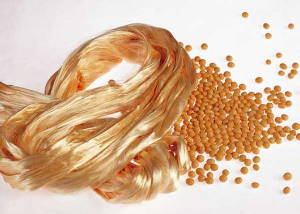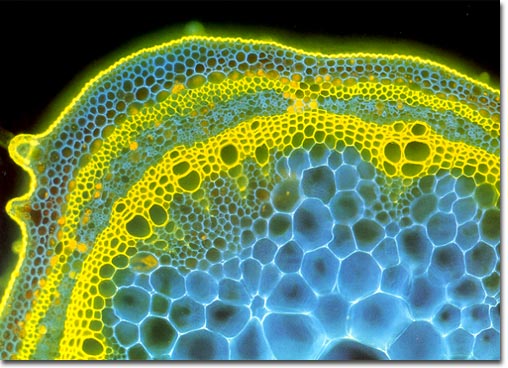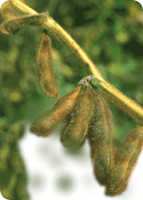
| ||||||||
 |
Soybean protein fiber
Introduction Soybean Protein Fiber or SPF is the only renewable botanic protein fiber we can touch today. SPF is a unique Active Fiber. Its 16 amino acids are healthy and nutritional to people's skin. Its moisture absorption, ventilation, draping and warmth cover the superior performances of natural fibers and synthetic ones. SPF has the softness and smoothness of cashmere, but doesn't cause hazard to the environment. Its products are degradable by landfill back to the earth. This fiber comes from soybean, a plant massive in sourcing and rich in nutrition. People usually eat soybean but now are able to wear it. Soybean Protein Fiber is the only botanic protein fiber in the world, a newly born guard to mankind's skin. You will never have felt such softness, comfort and smoothness before; it is a feeling like "skin on skin". It is an active fiber, a new green textile fiber, and it possesses the superiorities of many natural fibers and synthesized ones. Soybean Protein Fiber is an advanced textile fiber. It is made from the Soybean cake after oiling by new bioengineering technology. Firstly, the spherical protein is distilled from the soybean cake and refined. Secondly, under the functioning of auxiliary agent and biological enzyme, the space structure of spherical protein changes, and then protein spinning liquid is confected by adding high polymers, and then thirdly, after the liquid is cooked, the 0.9~3.0dtex fiber is produced by wet spinning, and stabilized by acetalizing, and finally cut into short staples after curling and thermoforming.
Transverse section of
soybean stem, stained with two fluoro chromes to show distribution
of cellulose (blue) and lignin (yellow) (50x) Soybean protein fiber is praised as the health, comfortable and
green fiber of the new century. Its major material is soybean
protein from the farmers, massive in quantity and inexpensive in
price, and using it will not cause the predatory development on the
resources but is helpful to resources' recovery and redevelopment.
The production of soybean protein fiber will not bring pollution to
the environment, as the accessory and auxiliary agent used are not
poisonous, while the residue after the protein extracted can be
still used as feed. Soybean Protein Fiber has not only the
superiorities of the natural fibers but also the physical properties
of synthetic ones. Soybean protein fiber meets the people's demand
of comfortable and beautiful wearing and also conforms to the trend
of easy care. It is the potential material for middle and high class
clothing in textile industry.
For more information please check out our other soybean protein fiber pages here or follow one of below links
The soybean (Glycine max) is often called the miracle crop. It is the world's foremost provider of protein and oil. The bushy, green soybean plant is a legume related to clover, peas and alfalfa. Farmers plant soybeans in the late spring. During the summer, soybeans flower and produce 60-80 pods, each holding three pea-sized beans. In the early fall, farmers harvest their crop for these beans which are high in protein and oil. A 60-pound bushel of soybeans yields about 48 pounds of protein-rich meal and 11 pounds of oil. More soybeans are grown in the United States than anywhere else in the world. In 2001, U.S. soybean farmers harvested a record 2.89 million bushels (78.7 million metric tons) of soybeans. More than half the total value of the U.S. soybean crop is exported as whole soybeans, soybean meal and soybean oil. As early as 5,000 years ago, farmers in China grew soybeans. In 1804, a Yankee clipper ship brought soybeans to the U.S. When leaving China, sailors loaded the ship with soybeans as inexpensive ballast. When they arrived in the U.S. they dumped the soybeans to make room for cargo. In 1829, U.S. farmers first grew soybeans. They raised a variety for soy sauce. During the Civil War, soldiers used soybeans as "coffee berries" to brew "coffee" when real coffee was scarce. In the late 1800s significant numbers of farmers began to grow soybeans as forage for cattle. In 1904, at the Tuskegee Institute in Tuskegee, Alabama, George Washington Carver began studying the soybean. His discoveries changed the way people thought about the soybean; no longer was it just a forage crop. Now its beans provided valuable protein and oil. By 1929, U.S. soybean production had grown to 9 million bushels. That year, soybean pioneer William J. "Bill" Morse left on a two-year odyssey to China during which he gathered more than 10,000 soybean varieties for U.S. researchers to study. Some of these varieties laid the foundation for the rapid ascension of the United States as the world leader in soybean production. Prior to World War II, the United States imported 40 percent of its edible fats and oil. At the advent of the war, this oil supply was cut. Processors turned to soybean oil. By 1940, the U.S. soybean crop had grown to 78 million bushels harvested on 5 million acres, and the United States was a net exporter of soybeans and soybean products. That year, Henry Ford took an ax to a car trunk made with soybean plastic to demonstrate its durability. The publicity increased the soybean's popularity. In the early '50s, soybean meal became available as a low-cost, high-protein feed ingredient, triggering an explosion in U.S. livestock and poultry production. The U.S. soybean industry began to look at ways to expand export markets. In 1956, the American Soybean Association (ASA) began to promote U.S. soybeans in Japan. Today, with funding from the United Soybean Board, qualified state soybean boards, and the U.S. Department of Agriculture, ASA promotes U.S. soybean and product exports in more than 100 countries around the world. Today, farmers in more than 30 states grow soybeans, making soybeans the United States' second largest crop in cash sales and the number one crop in terms of the value of exports.
SOYBEAN COMPOSITIONSoybeans are grown primarily for their protein content, and secondarily for their oil. But that is only the beginning of the story because processing of soybeans yields a number of other products as well. In the main form of processing, or "crushing" as it is often called, the soybeansare cleaned, cracked, dehulled, and rolled into flakes. This ruptures the oil cells for efficient extraction. The "crude" oil is removed with solvents or screw presses, and after further processing the refined soybean oil goes into such products as margarine, salad dressings, and cooking oils. After the oil is extracted, the flakes are toasted and ground to produce soybean meal, most of which is used as a high-protein component of animal feeds. However, some of it is also processed into products for human consumption. These include soy flour, soy protein concentrate, and soy protein isolate which can be incorporated into a wide range of food products. In recent years, we have learned that isoflavones and other phytochemicals found in the soybean meal portion have documented health benefits. These are now being extracted and marketed as nutriceuticals in functional foods. The soy hulls removed in the initial crushing can be processed into fiber for
use in breads, cereals and snacks. Lecithin, extracted from soybean oil, is used
for everything from pharmaceuticals to protective coatings. It is a natural
emulsifier and lubricant. Lecithin is used, for example, to keep the chocolate
and cocoa butter in a candy bar from separating. Soybean oil is also a natural
source of vitamin E. That portion of the vitamin E that is extracted as part of
the refining process is recovered and marketed with other vitamin supplements.
Nevertheless, refined soybean oil remains a good source of vitamin E.
| |||||||
| Be notified of page updates |
wwwswicofilcom2015




